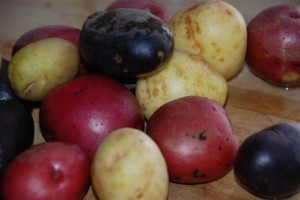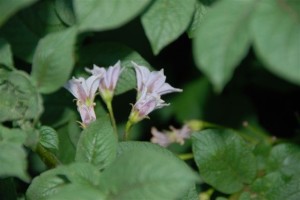Dig those new potatoes
A friend of mine sent me a link to a story on foods to be featured in Minnesota this summer. It seems that 2009 is the year of the potato for those folks up north. This doesn’t sound like a bad thing, except that at the Minnesota State Fair, most of their foods are served on a stick.
Oh what an indignity this is for the noble spud, to be skewered like a vampire with a stake through its heart. The food they’ve concocted – like the “Fry Dog,” where French fries are glued by batter to a hot dog and then the whole thing deep fried, or the “Texas Tater Dog” with a spiral cut potato wrapped around a German sausage before frying – can only be described as a cardiologists’ nightmare.
Why do this to a sweet, flakey, creamy spud? 

We’re nearing the start of new potato season in Colorado, when young tubers can be tickled from the ground. These fingerlings can be dug two to three weeks after the potato plant has finished blooming, which the earliest varieties of potatoes have just begun to do. When digging, you often have to lift the entire plant to get at the tubers, but in softer soil you can gently brush the soil away from the hill, harvest only the largest of the fingerlings, and replace the soil to let the rest of the potatoes grow. 

Be careful when digging up new potatoes; their skin is thin and easily bruised. Keep them out of the sun so they don’t turn green by taking them immediately into the kitchen.
Potatoes growers in Colorado may not have to worry about wild eyed northern barbarians showing up to skewer their spuds, but you do have to contend with another bane of summer: psyllids. These insects don’t winter here – they’re tourists, arriving in mid-summer from another state, laying claim to the best camping spots, inviting all their friends and family, letting the kids run wild, gobbling up our resources, then leaving the place looking yellowed and spent.
But in this case the tourists are psyllids (Bactericera cockereli), small, winged, sap feeding insects whose toxic saliva causes the plant to grow oddly. Their young look like scale – flat and oval. The tiny adults are dark with big, jewel-toned eyes and lighter bands on the abdomen.
Psyllids migrate northward during summer – coming up from Texas, Arizona, or New Mexico – arriving in our area to wreak havoc on potatoes and tomatoes. Look for leaves turning yellow with purple veins, or the plant appearing as if sugar were spilled on it. This crystalline dust is their waste, called lerps, and is an easy-to-see clue that your plant has become the vacation destination for these bad bugs. 

Psyllids can mean big problems for potatoes if they’re attacked after tubers have started developing, stunting growth and creating oddly shaped spuds. If harvested, the potatoes from infested plants don’t store well, sprouting prematurely.
Scout your plants – carefully checking for insects or disease by lifting leaves examining them. Check all of your plants every three days, and at the first sign of trouble, begin spraying with insecticidal soap to keep insects at bay. Coverage of both upper and lower leaf surfaces is crucial to control, but may not be enough.
Should the insects get the upper hand, move up to sprays containing an extract of neem oil. Make sure your spray won’t harm plants by checking the label to ensure it’s listed for use on potatoes, then test it on a leaf or two a couple of days before spraying.
With these tips your spuds will grace your table with dignity, and sticks are purely optional.

No comments:
Post a Comment